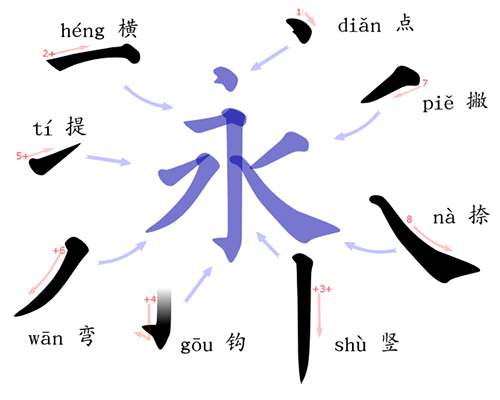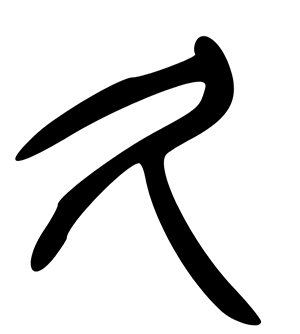4. The "Katakana No" Radical: 丿
The 丿 radical is starkly simple, featuring just one stroke and a little flair at the end. Nevertheless, it's one of the murkiest radicals I've ever encountered.
Plenty of kanji are slotted under a radical for convenience. In such cases, the character contains a component that kind of resembles the radical, and as the kanji really doesn't fit anywhere else, that's close enough for the categorization.
However, it's rare to encounter a radical category where none of the kanji have a good reason for being there. That's what we have with all four Joyo kanji in which 丿 is on duty:
乗 (320: to ride, get aboard; mathematical power, mathematical multiplication; take advantage of; feel like doing)
久 (647: long time; lasting)
及 (1148: to reach; attain; and)
乏 (1805: shortage)
I believe somebody filed each of these characters under 丿 with an "oh, just put it anywhere" mentality.
To make matters even murkier, it's tricky to identify the 丿 in most of these shapes. The leftmost strokes in 及 and 久 constitute the radical. As for 乗 and 乏, the topmost strokes fit the bill, though they hardly possess the marked tilt of 丿.
Photo Credit: Eve Kushner
The topmost stroke in 乗 is barely more slanted than the first stroke in 下 (7: below, down; to descend). Nevertheless, 丿 is the on-duty radical in 乗, whereas 下 contains the "one" radical 一.
The word 下乗 (げじょう) means "dismounting," so this sign at Toshogu Shrine in Nikko (in Tochigi Prefecture on Honshu) tells people where to get off a horse or palanquin. However, no one arrives at shrines that way anymore, so this sign is simply a charming throwback to the past.
What Is the 丿Radical Called?
The 丿radical is generally known as の, a reference to how much it resembles the katakana ノ (pronounced の). Thus, we can refer to the radical in 久 and 及 as の.
When the radical crowns a character, the name becomes のかんむり. (For more about かんむり, go to Radical Terms, find the "Radical Positions" section, and read about Position 3.) That longer name works for 乗 and 乏.
In quite a departure from this nomenclature, はらいぼう is another workable name for our radical. The ぼう corresponds to 棒 (stick), referring to how 丿resembles a stick. The term はらい (払い) represents a way of drawing a stroke with a tapering curve, which is how calligraphers render the katakana ノ. See, for instance, strokes 6 and 8 of this diagram:

The English names for the 丿 radical mirror the Japanese ones; options include "katakana no," "no," and "kana no," as well as "no kanmuri" when the radical is on top. (Actually, I hesitate to say that those are English names!)
How Has ノ Influenced Other Radical Names?
As long as we're talking about katakana ノ, I'll share ways in which it has influenced four other radical names:
• 攴 (radical 66, the "strike" radical) has the variant shape 攵, which is called のぶん. That name comes from ノ + 文 (read as ぶん). Someone perceived 攵 as a mashup of those two.
• 爪 (radical 87, the "claw" radical) is primarily called つめ but also has several other names, including のつかんむり, which breaks down as の + つ + かんむり. We've already seen that かんむり is the position name when a radical crowns a character, so のつかんむり applies to the radical variant 爫, as in 受 (303: to receive). The のつ part reflects the idea that 爫 looks like ノ + ツ.
• 禾 (radical 115, the "grain" radical) is called のぎ. This is a combination of ノand 木 (き: tree), which has been voiced as ぎ. That is, someone thought the top "branch" of 禾 resembled the katakana ノ.
• 釆 (radical 165, the "topped rice" radical) is called のごめ because ノ appears to lie atop 米 (こめ: rice), which has been voiced as ごめ.
Photo Credit: Eve Kushner
I love the brushed look of the writing in this sign, which features 久 at the heart of 天久利 (てんくり). That's the name of a restaurant in the Yurakucho section of Tokyo.
What Does the 丿 Radical Mean?
The 丿 radical inherently means nothing, so it's no surprise that it has zero semantic value in these four characters. The newer edition of Henshall supplies etymologies for each one, seldom mentioning the 丿 shape much less extracting meaning from it. Only in one case does he possibly draw attention to our radical:
久 (647: long time; lasting)
Henshall says the character combines 人 (person) with one stroke (typically taken to mean "hold back"). Together these parts mean "stop, stand still," extending to "be late" and then "long time."
Instead of seeing 人 plus one stroke, I see 人 plus ク, which consists of two strokes. But an ancient form of this character looked more like 人 plus one stroke:

© Richard Sears
Seal-script version.
I love this etymology for the way it ends. Henshall notes that one scholar sees 久 as representing "person with bundle of traditional Chinese herbs placed behind, for moxibustion." What a lot to glean from so few strokes!
Perhaps Henshall also isolates a single stroke in the next etymology, though I'm not sure if our radical is the said stroke:
及 (1148: to reach; attain; and)
Early forms show a "hand right behind—or holding—the leg of a person in front," giving "to catch up with, reach" and by extension "to extend to."
It sounds like an ancient game of Twister.
The next etymology also features an active, flexible person:
乗 (320: to ride, get aboard; mathematical power, mathematical multiplication; take advantage of; feel like doing)
The traditional form shows a person astride the top branches of a tree (i.e., climbing, mounting). Later the character acquired the extended meanings "ride and load."
As you can see, there's no reference to 丿.
You won't find one in the last etymology, either, but don't miss it:
乏 (1805: shortage)
"Etymology unclear.... The graph's very simplicity makes it hard to interpret at present."
Henshall says more than that, but those are my favorite parts!
